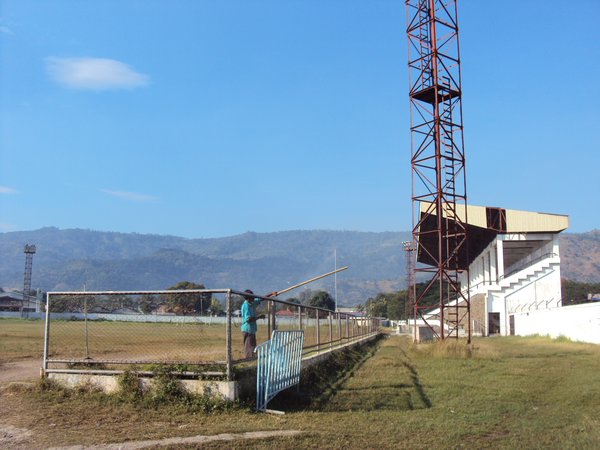
‘We cannot see our first win coming in the next few years but we will never quit,’ said the coach of the Timor-Leste national team, Pedro Almeida. ‘We have no resources to keep this team together and we barely have grass to play on.’
These bleak remarks came after Almeida’s Timor-Leste side had clocked up over two years stuck at the bottom of the world rankings with seemingly little hope of escape. Having joined FIFA in 2005, they played their first official matches the following year and promptly lost 5-0 twice within three days. Their place in the world order was set at dead last, and there it would remain as the new nation clocked up one defeat after another. Of all the countries who have become new members of FIFA since the rankings began, Timor-Leste were one of the weakest, most under-resourced, and least equipped to make a rapid breakaway from the bottom of the rankings.
‘The squad changes constantly because the players have families and cannot afford time off work,’ continued Almeida. ‘When they are twenty-one or twenty-two they have to quit.’ Such financial realities of life in the far reaches of football take their toll on squads, making international management at this level something of a juggling act. The frequent and extensive turnover of players makes establishing any settled team style or squad harmony that much more difficult. When football doesn’t pay, other priorities take precedence. Players on this lowly rung are sometimes too busy providing for their families to accept the call-up to play in a minor South-East Asian tournament.
The one professional player in their ranks was the captain Alfonso Esteves, a Portuguese of East Timor descent who accepted the call to represent his forebears’ home. After a stint playing in the minor professional leagues of the United States he moved to New South Wales’ Wollongong FC to allow him closer contact with Timor-Leste.
Added to those hindrances for Timor-Leste was the lack of even half-decent training facilities. Or even more fundamentally, the lack of much grass on their ramshackle, rock-strewn pitches, rendering them barely usable. ‘There is a lot of talent there and a lot of passion but there are no fields to play the game,’ Esteves explained. ‘There is no regular league. Sometimes, they organise tournaments for clubs to come together but when the tournament is finished there’s nothing. Sixty per cent of the population is under twenty-five but Timor has no jobs. The kids just spend the day hanging out doing nothing.’

‘Maybe it’s difficult to understand, but when you are on the field representing your country, every single improvement makes you feel so good,’ Esteves added. ‘The first game we ever played against the Philippines, we lost by seven goals. The next one we lost 1-0. Everyone was happy losing just 1-0.’ They were happy because it signified something. Choosing a positive outlook, it didn’t mean a missed opportunity or a sense of frustration at losing narrowly. Rather, it signified the huge steps that had been taken by the fledgling nation. It represented a progression towards competitiveness, albeit in the small pond of Timor-Leste’s particular region. It meant that there was hope. Hope that sooner rather than later, they would experience something other than defeat.
They had come close before. Very close. In the Asian preliminary rounds for the 2010 World Cup, held in late 2007, East Timor were paired with Hong Kong in a two-legged playoff. Unable to play at home in Dili’s dilapidated and decrepit stadium, they instead opted to play their ‘home’ leg in nearby Bali which they narrowly, agonisingly, lost 3-2.
Having run their more seasoned and experienced opponents so close in the first leg, redemption was not to be found in the return leg in Hong Kong. Their hosts finally showed their superiority in ruthless cold-blooded style, registering a resounding 8-1 win.
It would be another year before Esteves and his colleagues would play internationally again. Travelling to the Cambodian capital of Phnom Penh, Timor-Leste took their place in the qualifying group of the South Asian Championships, the AFF Suzuki Cup as it was known at the time, alongside the other lower ranked teams of South East Asia. Opening with the aforementioned and, by Esteves at least, fondly recalled 1-0 loss to the Philippines, the next opponents were their hosts, Cambodia.

Incredibly, they took the lead thanks to a stunning strike from distance by Anggisu Barbosa seconds before the interval. If that weren’t enough excitement for the Timor players to handle, they went two up midway through the second half when Jose Perreira picked himself up to convert a spot-kick having been fouled by the Cambodian keeper. Two ahead, they now had just twenty minutes to hold on, to survive, to endure.
Twenty minutes from success they may have been, but within the space of two minutes late in the game, the dream of victory was cruelly, callously, snatched away in a swift one-two. Cambodia converted a penalty kick of their own, moments before they grabbed a dramatic equaliser, leaving the Timorese facing the nightmare of potentially letting their best hope of victory slip agonisingly from their grasp.
They did indeed hold on to record their first ever draw, the first time they had not been beaten, which could easily have felt like a loss. The circumstances, having led by two, could have meant the Timor players slouched off the pitch feeling downbeat, disappointed and ultimately unfulfilled. And yet it meant nothing of the sort to Alfredo Esteves and his fellow players. Rather, it meant a remarkable first draw, a signal that their progress was continuing, that the right path was being taken, that their hopes of inspiring their nation were nearing realisation. It also confirmed that they were no longer the world’s whipping boys. A single draw it may have been, but it was a landmark achievement for the national side and heralded a climb up the rankings, at long last escaping the clutches of last place. Once more, the sporting press made use of the ‘worst in the world’ tag in headlines about this match, for instance ESPN’s “World’s Worst Team Clinch First Ever Point.”
Everyone was so delighted,’ Esteves said afterwards. ‘We know we are close [to winning]. The celebrations will be huge when we eventually win a match.’ His coach Pedro Almeida agreed: ‘It was the first game we didn’t lose. We’re all very proud.’
This article is adapted from a section of the book Worst in the World: International Football at the bottom of the FIFA Rankings.

Pingback: Worst in the World Tales: Timor-Leste | Aidan Williams Writer
I love this article.It reminds me of a great book that I read by a guy called James Montague. It’s called 31-0 and he follow the progress of tiny nations such as American Samoa and Haiti during qualifying for the 2014 World Cup. Well worth a read.
LikeLike